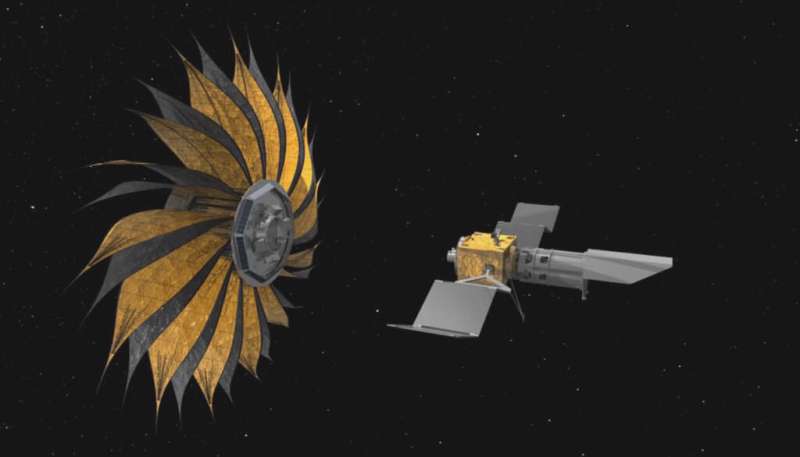
Copernical Team
Study: Explosive volcanic eruption produced rare mineral on Mars
 Planetary scientists from Rice University, NASA's Johnson Space Center and the California Institute of Technology have an answer to a mystery that's puzzled the Mars research community since NASA's Curiosity rover discovered a mineral called tridymite in Gale Crater in 2016.
Tridymite is a high-temperature, low-pressure form of quartz that is extremely rare on Earth, and it wasn't immediat
Planetary scientists from Rice University, NASA's Johnson Space Center and the California Institute of Technology have an answer to a mystery that's puzzled the Mars research community since NASA's Curiosity rover discovered a mineral called tridymite in Gale Crater in 2016.
Tridymite is a high-temperature, low-pressure form of quartz that is extremely rare on Earth, and it wasn't immediat Sols 3541-3543: Teamwork? Sure!
 Some planning days are more complicated than others, not because Mars throws us a curve ball, that happens, too, as regular readers of this blog will know. No, sometimes it's just plain old computer issues here on Earth that make things complicated. Today was such a day, and some of our personal computers hadn't properly updated one of the tools, but when we found out it was too late to diagnose
Some planning days are more complicated than others, not because Mars throws us a curve ball, that happens, too, as regular readers of this blog will know. No, sometimes it's just plain old computer issues here on Earth that make things complicated. Today was such a day, and some of our personal computers hadn't properly updated one of the tools, but when we found out it was too late to diagnose NOAA contracts with Planet to image oil spills, marine debris, and marine life
 Planet Labs PBC (NYSE: PL), a leading provider of daily data and insights about Earth, has announced a new contract with the National Oceanic and Atmospheric Administration (NOAA). The organization is leveraging Planet's PlanetScope and SkySat products to evaluate oil spills, track marine debris, detect vessels, and identify large marine mammals like whales.
In 2004, Hurricane Ivan caused
Planet Labs PBC (NYSE: PL), a leading provider of daily data and insights about Earth, has announced a new contract with the National Oceanic and Atmospheric Administration (NOAA). The organization is leveraging Planet's PlanetScope and SkySat products to evaluate oil spills, track marine debris, detect vessels, and identify large marine mammals like whales.
In 2004, Hurricane Ivan caused US-European satellite will make world's first global freshwater survey
 Water is life, but for all its importance, humanity has a surprisingly limited view of Earth's freshwater bodies. Researchers have reliable water level measurements for only a few thousand lakes around the world, and little to no data on some of the planet's important river systems. The upcoming Surface Water and Ocean Topography (SWOT) satellite will fill that enormous gap. By helping to provid
Water is life, but for all its importance, humanity has a surprisingly limited view of Earth's freshwater bodies. Researchers have reliable water level measurements for only a few thousand lakes around the world, and little to no data on some of the planet's important river systems. The upcoming Surface Water and Ocean Topography (SWOT) satellite will fill that enormous gap. By helping to provid Terran Orbital completes Space-to-Ground Optical Link demonstration on Pathfinder Technology Demonstrator 3
 Terran Orbital Corporation (NYSE: LLAP), a global leader in satellite solutions, primarily serving the United States and Allied aerospace and defense industries, has announced the first signal acquisition of the Terabyte Infrared Delivery (TBIRD) Lasercom Optical Link on NASA's Pathfinder Technology Demonstrator 3 (PTD-3) satellite.
Acquisition of the Lasercom Optical Link means that the s
Terran Orbital Corporation (NYSE: LLAP), a global leader in satellite solutions, primarily serving the United States and Allied aerospace and defense industries, has announced the first signal acquisition of the Terabyte Infrared Delivery (TBIRD) Lasercom Optical Link on NASA's Pathfinder Technology Demonstrator 3 (PTD-3) satellite.
Acquisition of the Lasercom Optical Link means that the s Eutelsat, OneWeb plan to merge
 French and British satellite operators Eutelsat and OneWeb on Tuesday announced plans to merge and create a "global champion" in the fast-growing broadband internet market, rivalling US giants such as Elon Musk's Starlink.
Eutelsat and OneWeb said in a joint statement they had signed a memorandum of understanding to join forces to become "a leading global player in connectivity... in an all-
French and British satellite operators Eutelsat and OneWeb on Tuesday announced plans to merge and create a "global champion" in the fast-growing broadband internet market, rivalling US giants such as Elon Musk's Starlink.
Eutelsat and OneWeb said in a joint statement they had signed a memorandum of understanding to join forces to become "a leading global player in connectivity... in an all- Preparing for the World's biggest radio telescope
 An international team of researchers has demonstrated that the Square Kilometre Array Observatory (SKAO) is capable of detecting radio emissions from normal spiral galaxies in the early universe. The SKAO, whose construction began this year, will soon be the largest radio telescope in the world. The astronomers, who are part of the SKAO's "Extragalactic Continuum" working group, are looking for
An international team of researchers has demonstrated that the Square Kilometre Array Observatory (SKAO) is capable of detecting radio emissions from normal spiral galaxies in the early universe. The SKAO, whose construction began this year, will soon be the largest radio telescope in the world. The astronomers, who are part of the SKAO's "Extragalactic Continuum" working group, are looking for Russia to quit International Space Station 'after 2024'
 Russia has decided to quit the International Space Station "after 2024", the newly-appointed chief of Moscow's space agency told President Vladimir Putin on Tuesday.
"Of course, we will fulfil all our obligations to our partners, but the decision to leave this station after 2024 has been made," Roscosmos chief Yury Borisov told Putin in comments released by the Kremlin.
Russia has decided to quit the International Space Station "after 2024", the newly-appointed chief of Moscow's space agency told President Vladimir Putin on Tuesday.
"Of course, we will fulfil all our obligations to our partners, but the decision to leave this station after 2024 has been made," Roscosmos chief Yury Borisov told Putin in comments released by the Kremlin. ESA showcases its space ambition at Farnborough airshow

ESA’s efforts to ensure European citizens reap the benefits of space have been highlighted at a global aerospace event held in the UK.
NASA wants your help designing a starshade to observe exoplanets

The field of exoplanet study has come a long way in recent decades. To date, 5,063 exoplanets have been confirmed in 3,794 systems beyond our own, with another 8,819 candidates awaiting confirmation. In the coming years, tens of thousands of more planets are expected to be found, thanks to next-generation observatories. The ultimate goal in this search is to find planets that are "Earth-like," meaning they have a good chance of supporting life. This is no easy task, as rocky planets located within their parent star's habitable zones (HZs) tend to orbit closely, making them harder to see.
To make this process easier, NASA is designing a hybrid observatory consisting of a "Starshade" that will block out a star's light so that a ground-based telescope can directly image planets orbiting it.
